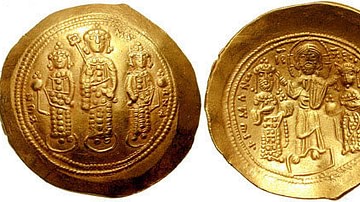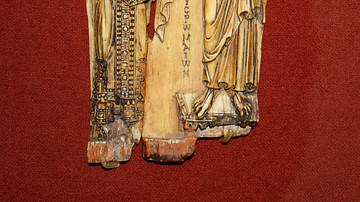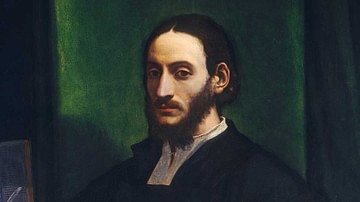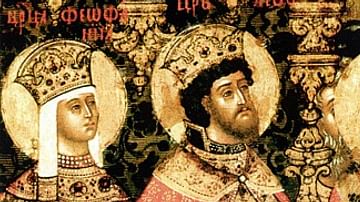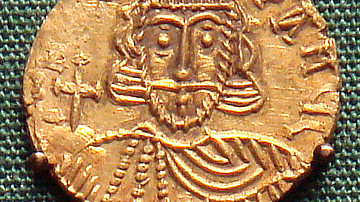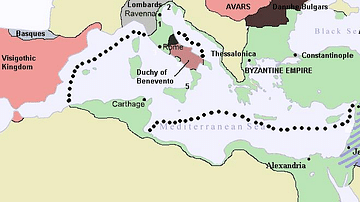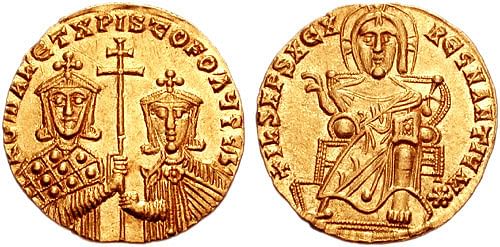
Romanos I Lekapenos (“the Ignorant”) was emperor of the Byzantine Empire from 920 to 944 CE. Of Armenian descent, he was a military commander who usurped the throne to rule as co-emperor with the rightful heir, but still minor, Constantine VII (r. 945-959 CE). Achievements made during his reign include peace with Bulgaria, a reconciliation between the conflicting sides of the church over how many marriages an emperor could have, and the instigation of land reforms to prevent the aristocracy gobbling up peasant lands. There were also significant gains made in expanding the empire in Mesopotamia and Armenia, including the acquisition of Melitene and several frontier fortresses.
Succession
Romanos' father, Theophylact the Unbearable, was an Armenian peasant who had once helped rescue Basil I (r. 867-886 CE) from the Arabs. In return for this act, Theophylact was given an appointment in the imperial guard. Romanos was born c. 870 CE and, like his father, he enjoyed a career in the Byzantine military and steadily made his way up the ranks on merit to become the strategos or military commander of the Samian province of the empire. He then went on to achieve the lofty position of commander of the imperial fleet in 912 CE. The Armenian, though, harboured even higher ambitions: the throne itself.
When Emperor Leo VI died in 912 CE, his chosen heir Constantine VII was still a minor at 6 years of age and so the young ruler's uncle Alexander seized his opportunity and declared himself emperor. Alexander's reign would last only one year as his debauched lifestyle finally caught up with him, and he died in the Hippodrome of Constantinople in 913 CE. Two more regents followed: Nicholas I Mystikos, the Patriarch (bishop) of Constantinople and then Zoe, Constantine's mother. Neither was successful in preventing damaging attacks from the Bulgars and, in 919 CE, Romanos took his chance to become yet another regent for Constantine while Zoe was banished to a nunnery. Romanos would have a few more obstacles yet, though, until he could comfortably seat himself on the Byzantine throne.
Known by the tag Lekapenos, which translates as “an ignorant fellow”, because of his humble origins, Romanos had received the backing of the supporters of the young Constantine because they feared Zoe was planning to marry herself into the powerful but treacherous Phokas family. Once Zoe married the general Leo Phokas it was unlikely that Constantine would ever rule in his own right. Romanos stepped up to the plate promising to protect the emperor's interests, appointing himself head of the imperial guard in the royal palace. Romanos then cemented his position by marrying his daughter Helena to Constantine in 919 CE.
Leo Phokas did not stand idle at this manoeuvre, and he sought to take by force what might have been his through marriage. A rebellion was whipped up, but Romanos responded with a cunning propaganda coup. The admiral, now calling himself basileopater or “father of the emperor”, had a letter spread amongst Leo's troops which showed in writing Constantine's support and trust of Romanos. Copies of the letter were circulated in Leo's camp by a priest and a prostitute, and they convinced the soldiers that Constantine was the legitimate ruler. Leo Phokas' supporters deserted him, and the general was captured and blinded in the usual horrific Byzantine punishment for those who had tried take power by force.
Triumphant, in 920 CE Romanos awarded himself the title of Caesar and then, three months later, co-emperor. Going a step further, Romanos then crowned his own three sons co-emperors with a higher status than Constantine. It looked very much like Romanos was intent on founding his own dynasty of emperors. To further consolidate his position and that of his family in Byzantine society, the emperor had several of his daughters marry into powerful noble aristocratic clans such as the Argyroi and Musele.
The Tetragamy
One of the first important domestic acts of Romanos' reign was the reconciliation between the two camps in the Byzantine Church who had argued fiercely over the third and fourth marriages of Leo VI (r. 886-912 CE). Previously, a third marriage by an emperor was regarded as unacceptable, and so when Leo, struggling to find himself a male heir, married for a third time, the crisis known as the tetragamy erupted. The ecclesiastical decree, called the Tome of Union, was passed in 920 CE and, while not posthumously condemning Leo, it did rule that his fourth marriage was illegal. Romanos' influence on Church policy was further consolidated when he made one of his sons the Patriarch in 925 CE, following the death of Nichols I Mystikos.
Land Reforms
Romanos was the first of a line of emperors who tried to improve the state treasury and the lot of the peasantry by curbing the growth of the wealthy landed estate owners known as the dynatoi. These landowners had been gobbling up small parcels of peasant holdings, which often meant a reduction in the state's tax revenue as the landed aristocracy were sometimes exempt from tax duties because of their military or political service. In addition, many peasants, having lost their land, now worked on those estates and so were a tax loss to the state. Accordingly, Romanos passed a law in 922 CE which forbade anyone to buy new land unless they already owned some in that particular village or had some other connection, as the historian T. E. Gregory here explains:
[Romanos] devised a system of protimesis (priority) which laid out clearly the order in which peasant land could be purchased. Thus, relatives, joint-holders, and neighbours were given priority, in carefully designated order; only when no one in these categories was able to purchase the land could it be sold to outsiders. Romanos even realised that there would certainly be violation of these principles and he declared that property acquired illegally would have to be returned, without compensation. (257)
The measures were not as successful as hoped and another edict was passed in 934 CE which noted that estate owners were, in any case, continuing to acquire new lands and that land must be returned to the peasantry. The problem of large landowners circumventing the law would continue to dog the land reforms of Romanos' successors, and the real underlying problem of extreme poverty which drove peasants to sell their land or which prevented them from purchasing any remained, too.
Defending the Empire
The Byzantine Empire had long been struggling with the ambitious Symeon of the Bulgars (r. 893-927 CE), and he moved to attack Constantinople during the chaotic years after Leo VI's death. Protected by the massive Theodosian Walls, both sides knew that the capital could withstand any siege, and when Symeon's attempt to enlist the naval help of the Fatamid Caliph in North Africa failed - Romanos had bribed them to remain neutral - the Bulgar leader accepted a generous tribute, the title of Emperor of Bulgaria, and went back home. The wars with the Bulgars finally ended with Symeon's death in 927 CE, which allowed Romanos to concentrate on offensives elsewhere. To ensure a lasting peace with Bulgaria, Romanos, besides paying another handsome tribute, was prepared to offer Symeon''s successor, Peter, his own granddaughter, Maria, in marriage.
The gifted general John Kourkouas (aka John Curcuas) was charged with campaigns in Armenia and Mesopotamia to consolidate and expand the Byzantine's interests there. Inconclusive confrontations finally led to a significant victory and the capture of Melitene in eastern Cappadocia in 934 CE. The Arab general who became Byzantium's nemesis was Sayf Al-Dawla (aka Saif-ad-Daulah), the Hamdanid emir of Mosul and Aleppo. Despite a Byzantine-Abbasid Caliphate alliance, Sayf inflicted a defeat on Kourkouas in 938 CE on the upper Euphrates and won another important victory near Aleppo in 944 CE. However, in the previous year, Kourkouas had managed to capture the Mesopotamian frontier fortresses of Nisibis, Dara, Amida, and Martyropolis. Finally, in 944 CE, the Byzantine general besieged Edessa in Upper Mesopotamia and forced the city to relinquish the celebrated mandylion, a shroud believed to carry the impression of Jesus Christ. Romanos' sons proudly paraded the mandylion through the streets of Constantinople, after which it was stored in the royal palace where it remained for the next 250 years.
In 941 CE the Rus (descendants of Vikings who had settled around Kiev) launched a failed attack on the Theodosian Walls of Constantinople. Greek Fire, the secret Byzantine weapon of inflammable liquid ensured the Viking ships were easily dealt with at sea, and the arrival of John Kourkouas - recalled from Asia - ensured they were also routed on land.
Death & Successors
Unfortunately for Romanos' dynastic plans, his eldest and most able son, Christopher, died in 931 CE and the two remaining sons, not quite so bright, made a poor political move when they invited Constantine to join them in 944 CE to oust their father. Romanos had made signs that given Christopher's untimely death it was perhaps in the empire's best interests to have Constantine as full emperor with Romanos' daughter as his consort maintaining a family connection and perpetuating the Romanos line. When his two sons got wind of the plans to name Constantine as the official heir, they staged a coup against their father in December 944 CE and banished him to a monastery. Fortunately for Constantine, there was significant support at court to return the throne to the legitimate line of descent, and the Romanos boys were kicked out of Constantinople on 27 January 945 CE. Constantine could finally take the throne in his own right, aged 39: it was better late than never. Romanos, still in a monastery in the Princes' Islands off the coast of Constantinople, died on 15 June 948 CE.
This article was made possible with generous support from the National Association for Armenian Studies and Research and the Knights of Vartan Fund for Armenian Studies.

